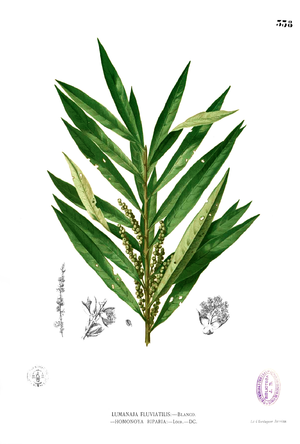Note: This is a project under development. The articles on this wiki are just being initiated and broadly incomplete. You can Help creating new pages.
Difference between revisions of "Homonoia riparia"
(→Common names) |
|||
| Line 11: | Line 11: | ||
==Common names== | ==Common names== | ||
| − | {{Common names|sa=Jalavetasa|en=|gu=|hi=Sherni|kn= | + | {{Common names|sa=Jalavetasa|en=|gu=|hi=Sherni|kn=Hole nage|ks=|ml=Neervanchi|mr=Raan kaner|pa=|ta=Kattalari|te=Adavi ganneru}} |
==Properties== | ==Properties== | ||
Latest revision as of 12:15, 18 May 2020
Homonoia riparia can be a gregarious, deciduous shrub, or a small, crooked and twisted tree, growing 1 - 4 metres tall and forming a woody, deep and extensive root system. The shrub provides a number of popular local medicines, which are gathered from wild plants. It is planted in Java and Sumatra in order to protect riverbanks and prevent soil erosion.
Contents
- 1 Uses
- 2 Parts Used
- 3 Chemical Composition
- 4 Common names
- 5 Properties
- 6 Habit
- 7 Identification
- 8 List of Ayurvedic medicine in which the herb is used
- 9 Where to get the saplings
- 10 Mode of Propagation
- 11 How to plant/cultivate
- 12 Commonly seen growing in areas
- 13 Photo Gallery
- 14 References
- 15 External Links
Uses
Itches, Skin diseases, Malaria, Scabies.[1]
Parts Used
Chemical Composition
Common names
| Language | Common name |
|---|---|
| Kannada | Hole nage |
| Hindi | Sherni |
| Malayalam | Neervanchi |
| Tamil | Kattalari |
| Telugu | Adavi ganneru |
| Marathi | Raan kaner |
| Gujarathi | |
| Punjabi | |
| Kashmiri | |
| Sanskrit | Jalavetasa |
| English |
Properties
Reference: Dravya - Substance, Rasa - Taste, Guna - Qualities, Veerya - Potency, Vipaka - Post-digesion effect, Karma - Pharmacological activity, Prabhava - Therepeutics.
Dravya
Rasa
Guna
Veerya
Vipaka
Karma
Prabhava
Habit
Identification
Leaf
| Kind | Shape | Feature |
|---|---|---|
Flower
| Type | Size | Color and composition | Stamen | More information |
|---|---|---|---|---|
| {{{5}}} |
Fruit
| Type | Size | Mass | Appearance | Seeds | More information |
|---|---|---|---|---|---|
Other features
List of Ayurvedic medicine in which the herb is used
Where to get the saplings
Mode of Propagation
How to plant/cultivate
Found in lowland tropical areas at elevations up to 500 metres.[4]
Commonly seen growing in areas
Restricted to river banks, Lake shores, Rocky stream beds, Seasonal climatic condition.
Photo Gallery
References
- ↑ Indian Medicinal Plants by C.P.Khare
- ↑ [Chemistry]
- ↑ [Morphology]
- ↑ Cultivation
External Links
- Ayurvedic Herbs known to be helpful to treat Itches
- Ayurvedic Herbs known to be helpful to treat Skin diseases
- Ayurvedic Herbs known to be helpful to treat Malaria
- Ayurvedic Herbs known to be helpful to treat Scabies
- Herbs with Young shoots used in medicine
- Herbs with Seeds used in medicine
- Herbs with Roots used in medicine
- Herbs with common name in Kannada
- Herbs with common name in Hindi
- Herbs with common name in Malayalam
- Herbs with common name in Tamil
- Herbs with common name in Telugu
- Herbs with common name in Marathi
- Herbs with common name in Sanskrit
- Habit - Deciduous shrub
- Index of Plants which can be propagated by Seeds
- Index of Plants which can be propagated by Cuttings
- Herbs that are commonly seen in the region of Restricted to river banks
- Herbs that are commonly seen in the region of Lake shores
- Herbs that are commonly seen in the region of Rocky stream beds
- Herbs that are commonly seen in the region of Seasonal climatic condition
- Herbs
- Pages without herbs images

